Are you looking to hike your favorite trail this winter? That’s awesome! Just because the weather is cold and windy doesn’t mean you have to curl up all day long in your house. But before you set off to the trailhead, make sure you put on the right boots.

Good winter hiking boots will not only keep you comfortable as you walk miles, but also protect you from permanent frostbite damage. Below, you can learn about a number of winter hiking boots and why they’re the best options. Also, all of these boots are great for snowshoeing too (if you hike and backpack in winter, there’s a good chance you’re going to snowshoe as well because, in some parts of the trail, the snow is just too deep to blaze through without). They’re not necessarily heavy, but they provide enough insulation and secure fit for the snowshoe binding.
Best Winter Hiking Boots
For Men
| Winter Hiking Boots | Insulation | Weight | Height |
|---|---|---|---|
| Salomon X Ultra Winter | 200g Thinsulate | 2 lbs. 7 oz. | 6.5-inch |
| KEEN Summit County III | 400g Synthetic | 3 lbs. 4 oz. | 8-inch |
| Columbia Bugaboot Plus III | 200g Omni-Heat | 2 lbs. 14 oz. | 7-inch |
| Salomon Toundra | Ultralight Aerogel Foam | 1 lb. 7 oz. | 8-inch |
| Merrell Moab Polar | 400g Synthetic | 2 lbs. 12 oz. | 6.5-inch |
| Vasque Snowburban UltraDry | 400g Thinsulate | 3 lbs. 3 oz. | 8-inch |
| KEEN Durand Polar | 400g Synthetic | 3 lbs. 3 oz. | 7.5-inch |
For Women
| Winter Hiking Boots | Insulation | Weight | Height |
|---|---|---|---|
| Vasque Pow Pow II UltraDry | 400g Thinsulate | 2 lbs. 11 oz. | 8-inch |
| Ahnu Northridge | 200g Thinsulate | 2 lbs. 4 oz. | 9-inch |
| Merrell Fluorecein Shell 8 | 400g Synthetic | 2 lbs. 3 oz. | 7-inch |
| KEEN Revel III | 200g Synthetic | 2 lbs. | 5-inch |
| Merrell Snowbound | 200g Synthetic | 2 lbs. | 6-inch |
| Vasque Snowblime UltraDry | 200g Thinsulate | 2 lbs. 8 oz | 5.5-inch |
| The North Face Shellista II | 200g Heatseeker | 2 lbs. 4 oz. | 8.5-inch |
Not all winter boots are made equal. Some are more geared toward casual use around the town, hence emphasizing on style and comfort, so you can use them all day without your feet begging for mercy. With lightweight insulation, they’re obviously not meant for use in extreme cold in the wilderness.
Some others, however, are the complete opposite. They may not look catchy, but their tough construction and thick insulation lining allow you to plow through the coldest snow, making them ideal for working in the dead winter like snow shoveling, wood chopping, and ice fishing. Just don’t expect to cover a long distance in them because they’re absolutely heavy and way too stiff for long walks.
Both types of those boots are not ideal for hiking in winter. You need boots that have the best of the two worlds: ones that are not only lightweight and comfortable to walk with for miles but also provide synthetic or wool lining thick enough to protect you against the cold. In general, you will want boots that are:
- Waterproof, so that melting snow won’t creep in and get you cold feet. Such is achieved by incorporating rubber lowers and plastic or leather uppers.
- Insulated, so that you won’t get any frozen toe. At the very least, you want boots with 200g of synthetic lining and rated -20F.
- Stiff, so that you can equip them with crampons to add more traction on icy terrain. Flexible soles don’t get along with crampons. Besides, boots with a stiff sole can help you save more energy when snowshoeing.
- Not too bulky, so that you can fit them into your snowshoe binding. Actually, many snowshoe makers design their snowshoe bindings to be large enough to accommodate even Pac style boots.
All best winter hiking boots listed above met such criteria. I doubt you can be wrong with any of them. Just make sure you choose the right size.
Best Men’s Winter Hiking Boots
Salomon X Ultra Winter
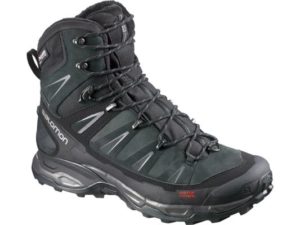
Salomon is one of the best footwear manufacturers in North America. Their hiking boots and trail shoes have received countless positive reviews from users–despite the steep pricing–and that should speak of their product quality. Salomon X Ultra Winter, in particular, is developed from their highly-rated trail shoe of the same name. Despite being stuffed with 200g of synthetic insulation and featuring a higher collar, the boot still manages to retain its lightweight profile, making it the most nimble option in this list. The light amount of insulation means it’s not the warmest one though. So, if you think you’ll be freezing for a good while, opt for one with thicker insulation like the earlier Vasque Snowburban.
KEEN Summit County III
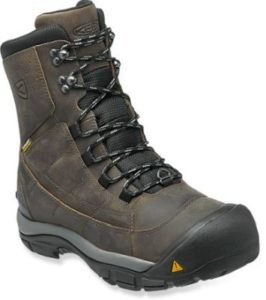
The Summit County III is easily the best winter hiking boot from KEEN. Not only does it maintain warmth most effectively, thanks to the 400g of synthetic insulation, but it also boasts durable built that’s going to last you many winters. It has been proven to protect users’ feet from frostbite even while post-holing 3-feet deep under heaps of snow for a few miles. Its shock-absorbing midsoles along with thick padding are guaranteed to provide you comfort as you blaze through the trail. A ten-mile hike should be an easy feat with this boot. Still, although KEEN Summit County III has a higher ankle than competitors, you will be needing a pair of gaiters if you don’t want to have a snow buildup on its collar that will eventually seep into its inner.
Shop now at Amazon.com
Columbia Bugaboot Plus III
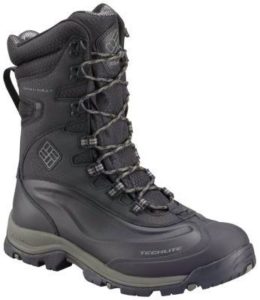
As a winter boot, Columbia Bugaboot Plus III ticks all the boxes, making it one of the most versatile options out there. In terms of weight, this boot is relatively light, thus should be comfortable for a long trek. Interestingly, it comes with pretty sturdy construction too, which should make it a fine choice for working. Its insulated lining is designed using the company’s Omni-Heat reflective technology (it’s really shiny on the inside). Such technology is claimed to preserve warmth better than other synthetic materials. So, despite only having 200g of insulation, you can wear it with confidence even when the temperature goes as low as 10F. On warmer days where the temperature can be 30F or higher, such minimalist insulation won’t make your feet all sweaty.
Buy Men’s Columbia Bugaboot III Buy Women’s Columbia Bugaboot III
Salomon Toundra
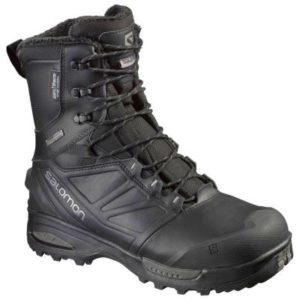
Salomon Toundra is the only boot in this list that features an insulation made of Aerogel. It’s a special material that’s developed by NASA to protect its Mars explorers from the planet’s frigid temperatures. So, when it’s listed to have a temperature rating up to -40F, I don’t think it strays too far from the truth. In addition to its warmth preserving capability, Aerogel is also much lighter than any synthetic insulation, making the boot nimbler than its competition. Mind you, each boot weighs barely over one pound. So, instead of pulling down your feet like a dead weight, you’ll feel more like walking with a trail running shoe. As such, it’s a perfect boot for long winter trek where you’ll likely need to put on heavy crampons and snowshoes.
Buy Men’s Salomon Toundra Buy Women’s Salomon Toundra
Merrell Moab Polar
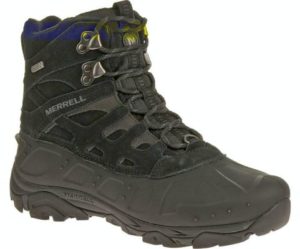
Compared to its competitors, Merrell Moab Polar is $50 cheaper or even more if you put it next to the pricier boots like KEEN Durand Polar. Yet, it’s a quality piece of work with a robust build. Its outsoles have a pattern similar to Merrell’s 3-season hiking boots but designed using different materials to provide better traction against the snow. While it does make the boot more “grippy,” the pattern tends to trap snow in between its small blocks. You may need to scrub it off every now and then. Packing 400g of synthetic insulation, this boot is made to tackle higher altitude terrain that’s naturally colder than any trail below the treeline. Just don’t forget to bring your gaiters because its height doesn’t extend much above your ankle.
Shop now at Amazon.com
Vasque Snowburban UltraDry
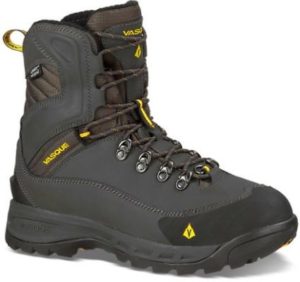
Vasque Snowburban UltraDry looks more like a regular hiking boot rather than a fully insulated boot made for trouncing around snow-covered trails. But, don’t let yourself be mistaken. Bringing a warm 400g of insulation, this boot is geared for use in more frigid temperatures on higher elevation. Its synthetic material is not any of those you can find around the corner but rather a special one called Thinsulate developed by 3M. It is known for its warmth and is used in many dedicated ski jackets and boots. However, just like Merrell Moab Polar above, its ankle height is too low to be used in deep snow without gaiters. Also, the heavy insulation may turn out to be too hot if you hike in warmer days.
KEEN Durand Polar
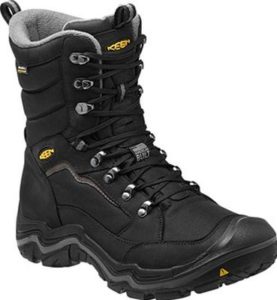
Unlike the Summit County III above, KEEN Durand Polar has a higher profile collar, extending its 400g of insulated layer well above your ankle, hence more warmth. Still, in the case of running across the deep powder, gaiters are still necessary to keep off the snow from making its way to the inside. Despite looking more like a Pac-style boot suited for working, it’s surprisingly comfortable and doesn’t feel overly stiff. You should be able to cover 10 miles or more without feeling any aching like you would with bulky rubber boots like Sorel and Baffin. Sadly, this boot is more on the expensive side. It’s likely because the assembly is done stateside rather than fully imported.
Buy Men’s KEEN Durand Polar Buy Women’s KEEN Durand Polar
Best Women’s Winter Hiking Boots
Vasque Pow Pow II UltraDry
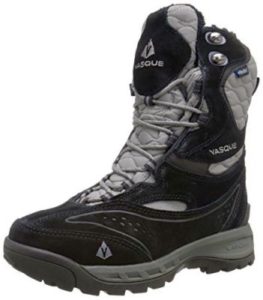
Anyone looking to hike the exotic winter wonderland in Iceland–or anywhere, for that matter–should consider getting Vasque Pow Pow II. Featuring 400g of Thinsulate insulation, it’s a rugged winter hiker designed specifically for women. It’s also completely waterproof; thanks to the inclusion of UltraDry membrane that’s been proven and used in the men’s Snowburban boot. At 2 pounds and 11 ounces, it’s not necessarily lightweight for a women’s boot, but that’s a small exchange, I suppose, for a solid build and warmth it offers. The collar is a little higher to give better support for your ankle, and it’s adorned with faux fur to make it look more stylish.
Shop now at Amazon.com
Ahnu Northridge

Ahnu may be a new bootmaker in the block, but their women’s specific products have garnered quite some positive feedback. The Northridge, in particular, is dedicated to female hikers who don’t want to be constrained by the cold weather in winter. Designed based on their top-rated hiking boot–the Montara–it offers fantastic support for winter hikes. It packs very little weight too for a winter boot, making it an ideal option for snowshoeing. The non-removable 200g of insulated lining means that it’s not built for extreme cold, but thanks to the extra height, it preserves warmth better. You should still feel comfortable with it even when the temperature starts to get lower than the freezing point.
Shop now at Amazon.com
Merrell Fluorecein Shell 8
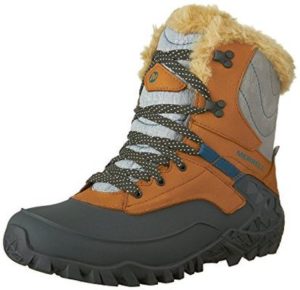
Even more stylish than Vasque Pow Pow II above is Merrell Fluorecein Shell 8, yet it doesn’t seem that Merrell was holding back when designing this boot. Spec-wise, it has almost the same feature as Pow Pow II. A fully waterproof membrane, a warm 400g of Merrell’s own synthetic insulation, and snowshoe-compatible outsoles: it has all you need from a winter hiking boot. If anything, it has a slightly lower ankle. Depending on what kind of hiker you are, some do prefer a boot with lower height as it encourages a freer range of motion. The boot tongue is also wide, providing more padded comfort for your outer feet. The faux fur on its collar helps keep off snow from getting in, but again you will want to wear gaiters if the snow is more than 4-inch deep.
Shop now at Amazon.com
KEEN Revel III
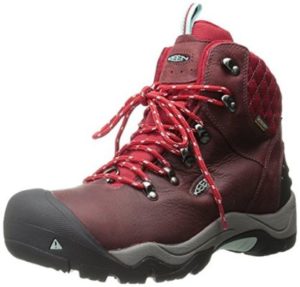
There’s hardly anything different from women’s KEEN Revel III from its men’s counterpart, except that it boasts bolder color selection. Unlike the three boots earlier, it comes with a clean and more minimalistic design with no faux fur to decorate its collar. A lighter 200g of insulation should make it weigh less, but in truth, it is not too different from Vasque Pow Pow II and Merrell Fluorecein Shell 8, which have twice as much insulated lining. The good news is, it performs remarkably well against cold weather. Together with its waterproof membrane, the insulation traps heat more effectively, allowing you to wander around at temperature well below freezing without feeling cold. The outsoles’ tread provides a good grip too against patches of ice on the ground.
Shop now at Amazon.com
Merrell Snowbound
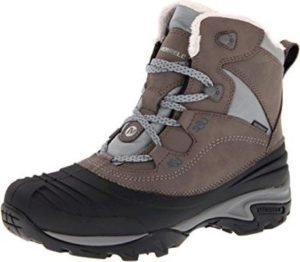
Merrell Snowbound is designed based on the Norsehund boot that is marketed for men. It’s given a few nice additions like rubberized toe section for better protection against elements and an extra insulated lining on the upper for the more efficient keeping of warmth. Sporting 200g of insulation, it’s a good boot for moderate hiking below the treeline. Interestingly though, Merrell claimed that it has a temperature rating up to -40F, which I think rather misleading. To survive such extreme cold without frostbite plaguing your toes, you need at least 400g of insulation and be very active on the trail. Aside from that, it’s a solid option for hiking in winter. Besides, I don’t think it makes a bad boot for casual use as well; thanks to the pretty application of fur fleece around the ankle.
Shop now at Amazon.com
Vasque Snowblime UltraDry
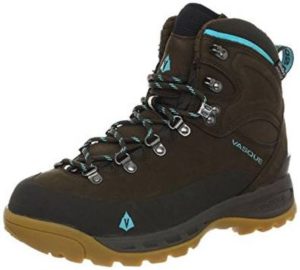
From the footbed to the upper, Vasque Snowblime UltraDry is stiff. You wouldn’t want it for everyday use as it’s not very comfortable, and lacing the boots can be quite a fuss. However, that’s exactly what you need to have a safe hike in winter. Boots with too soft uppers will suffer as you strap them into your snowshoes, exposing your feet to the pressure of the binding straps. Luckily, the toe box is roomy, and its collar is layered with a soft fleece, so it doesn’t rub your ankle and leave some hot spots. Its 200g of Thinsulate insulation gives off a nice warmth in good weather too, however, don’t count on it when the day is unusually cold or when you go to a higher elevation.
Shop now at Amazon.com
The North Face Shellista II
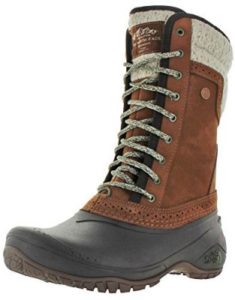
Now this might not look like a boot for hiking, but the North Face Shellista II has what it takes to be one. First off, it’s very lightweight. For a mid-calf boot, you’d expect it to weigh at least three pounds, but in reality, it’s only slightly over two pounds. The leather used to construct its upper is not very thick, and it only incorporates 200g of insulation. While those are not the best combination to keep your feet warm in frigid conditions, they do keep the weight in check. Furthermore, the lower part of the boot is made of rubber, which is not only waterproof but also non-compressible. Overall, it’s an okay option for a moderate hike below the treeline.
Shop now at Amazon.com
Types of Winter Hikes
Even among all of those winter hiking boots above, there’s bound to be some difference in performance. Depending on where you’re going to hike and backpack this winter (above or below the treeline), some boots may prove to work great, while others might turn out to be too warm or too cold.
Whether you’re going to move a lot or do a good deal of standing around in your hike may also be a deciding factor when choosing boots for winter hiking. You may get away with boots featuring thinner insulation if your trek requires you to be highly active. On the other hand, if it’s going to be a relaxed walk with a lot of standing and sitting in between, you’ll be safer with thickly insulated boots.
Below the Treeline
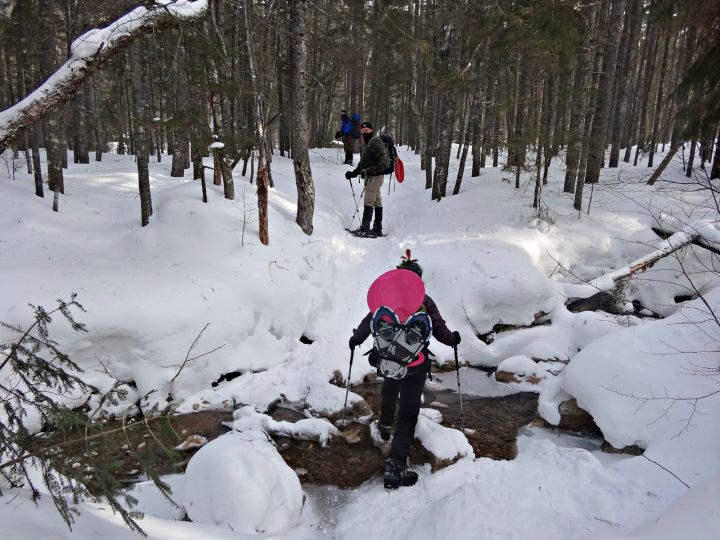
If it’s going to be a short hike in the lower end of the altitude, you should be all right going with lightweight boots like Salomon X Ultra Winter. Boots with 200g insulated lining can keep you warm up to 0-degree Fahrenheit to even as low as -20F, should you move a lot. The good thing about lightweight winter boots is they mostly come with a soft collar, which you can tie more securely around your ankle, as opposed to those hardshell boots. They also have no problem sneaking into the binding of your snowshoes.
Above the Treeline
Above treeline refers to the upper part of the mountain, approximately 4,500 feet. Though the beauty you can find at such altitude is often very rewarding, you will be more exposed to the elements. Wearing boots with thicker 400g synthetic insulation such as KEEN Durand Polar Hiking Boot is obviously a necessity. Stiff soles will also help you a lot because you will likely need to use crampons to walk over icy grounds. And as you ascend, you will have to kick those steps into the slope to get a more secure footing.
Overnight Trips
For overnight trips down the snowy trail, there’s no better option than full-fledged mountaineering boots. They’re an overkill for 7 or 8-mile hikes, but they can ensure that you have warm feet in case you have to spend a night or two to reach the white summit. They’re far stiffer and heavier too, in comparison to common winter hiking boots. However, such rigid construction is necessary to ensure its safety, durability, and compatibility with other hiking gears like crampons and snowshoes. Some mountaineering boots come with double construction (they have a separate removable boot inside them), while some others feature non-removable insulation just like other winter boots. Below are two of the best mountaineering boots that I know:
- La Sportiva Nepal Evo GTX
- Scarpa Men’s Phantom 6000
- La Sportiva Batura 2.0 GTX
- La Sportiva Spantik
- Scarpa Phantom Guide
Why They’re Great for Snowshoeing Too
- Their upper is tough: As you fit your feet into your snowshoe bindings, you’ll find it necessary to cinch the straps tightly around the boots’ upper, so that they can stay in place as you walk. Now doing that on boots with soft and compressible upper will likely get you cold toes because the straps put too much pressure on your feet and obstruct blood circulation. A tough and hard upper, however, can protect you from the said pressure.
- They have stiff soles: When you’re snowshoeing, you want to make sure that every movement you make is as efficient as possible. Trust me; it’s more exhausting than it looks, and for that, you don’t want to waste the slightest energy you have in you. Wearing boots with flexible soles contradict such an idea. Every time you flex your boots within the binding, you waste a little energy of yours. So, stiff soles are definitely more beneficial here. With soles that don’t flex, you can move more effectively, keeping you from fatigue much longer.
- They’re designed with waterproof materials: Breathable upper is nice, but when you hike in winter, you will want it to be more waterproof, instead. Snow can soak through your boots, and when it happens, you’ll be left with nothing but cold feet. That’s the last thing you want to deal with in a freezing winter trail. All winter hiking boots mentioned above feature waterproof rubber lower and come with waterproof lining, though not all of them are Gore-Tex.
- They sport warm insulated lining: If you aim to run in snowshoes, it may be fine to wear non-insulated footwear. In most cases, however, you’re going to snowshoe slowly and take a break often, especially if you’re a beginner. That may not be enough to raise your body temperature to a point that can make your feet warm. Boots with warm insulation can protect your feet from cold, even if the exertion level is low.
More Information about Winter Hiking Boots
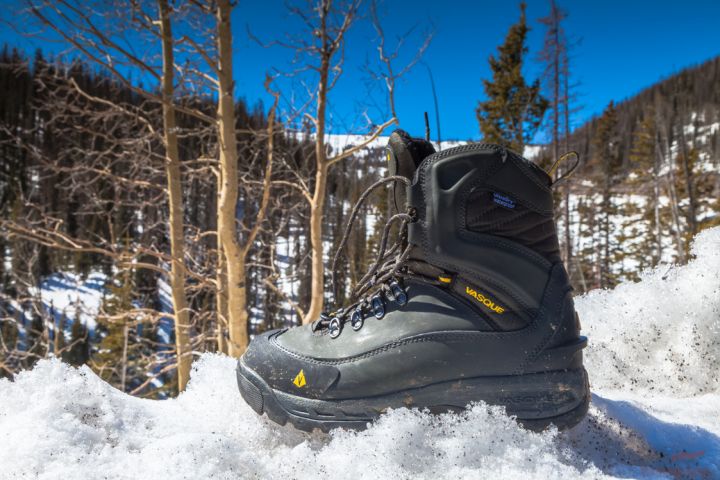
Temperature Ratings
Several boot manufacturers–Salomon, for example–disclose specific info regarding the temperature in which their boots can perform most efficiently. The ratings commonly range from -25F to -40F. The bulkier Baffin snow boots are even claimed to withstand extreme cold up to -148F, which sounds insane, really. As impressive as they are, I’d recommend taking them with a grain of salt because, as of now, a standardized test is yet to be conducted to precisely measure them. I myself am not interested to test them. I don’t know about you, but a temperature of -40F can shake you to your bone and may as well freeze a toe or two of yours, especially if you’re not too active or won’t take a break a lot on the trail. As it stands, the boots’ ability to keep you warm depends on a few factors, such as a level of exertion, age, and the weather itself. That said, it’s best to consider the boots’ temperature rating as mere guidance, instead of a sure thing.
Insulation
The majority of winter hiking boots today incorporate a lining made of synthetic materials. Unlike Pac-style boots, their insulation layer is non-removable. As such, it has its own advantage and disadvantage as well. The good thing about the non-removable insulated layer is you can be sure it won’t be exposed to the elements on the trail. The bad thing, however, is they’re more prone to growing unpleasant odor, particularly if your boots are not very breathable.
There are a few common synthetics used in winter hiking boots; the most popular of which are Primaloft and Thinsulate. They’re used in numerous jackets, glove, and boots intended for winter sports. Although they’re lightweight and not necessarily thick, they prove to be effective insulation as they can still keep the warmth inside even when they’re wet. Some bootmakers develop their own insulation material like The North Face with its Heatseeker and Columbia with its Omni-Heat (I believe the latter is better).
To get an idea of how warm they are, you can take a look at the number of grams. Midweight boots are usually equipped with 200g of insulation and may still be warm enough up to 0-degree Fahrenheit. More serious boots meant for hiking above the treeline offer 400g of insulation and still provide safe protection against the cold even when the temperature dips well below zero.
Boots Height
Winter hiking boots are designed to be comfortable for a long walk, thus most come with a height no more than a few inches above your ankle. The fact that their uppers don’t extend too high makes it very easy to get in and out of them. The deep powder will pose an issue to such boots, but you’ll walk through it just fine if you pair them with gaiters. Some, however, are as high as your mid-calf. While they may not be too easy to get on and off, their insulation layers carry on along with their height, offering more warmth in cold weather. They also often look more stylish (The North Face Shellista II, for instance), giving you a chance to put them on for more casual use around the town. Still, their extra height doesn’t do any good in promoting a free range of motion. If anything, it only limits it.
Materials and Waterproofing
Most, if not all, winter hiking boots have their lower made of rubber. It is considered the best material to combat wind and prevent any moisture to seep in. Needless to say, it’s also tough and long-lasting. Its stiff nature may not be too comfortable for casual use, but it’s necessary for the feet muscle to work more efficiently, saving you from early fatigue.
As for the upper, most feature leather. Some winter boots use nylon to construct their upper, though, and it’s best to stay well away from them. Nylon, while more breathable than leather, is more absorbent to moisture. You don’t want to end up with damp or even wet boots on the snow, do you? Speaking of wet, all winter boots designed for hiking are waterproof, though the inner lining used to achieve it is different from one another. Many of them use proprietary material, instead of the popular Gore-Tex.
Traction Device
The outsoles of winter hiking boots are specifically designed to provide some traction against an icy surface, so you won’t likely slip as you walk. In truth, however, they’re not enough. Even the best rubber with the most “grippy” sole pattern can’t provide a steady footing over the slippery frozen trail. You’re going to need a dedicated traction device if you want to walk through without tumbling down. Luckily, such gear is inexpensive. Depending on the aggressiveness of the traction, you can get them for less than $60. Those with mild traction like Yaktrax Pro cost less than $20. Note that not all traction device is flexible, so if you use them with boots that have flexible soles, you will likely ruin it. Also, it takes a little time to put it on properly, and you may have to take off your gloves to do that.
